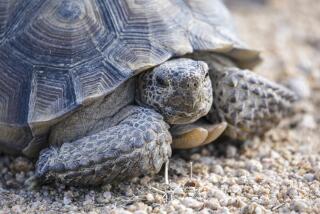CREATURE FEATURE : Love Is a Many-Legged Thing
- Share via
It has been described as the desert’s equivalent of a singles bar on a Saturday night--all the boys are out and lookin’ for love. For me and a lot of other city folks, however, the fall spectacle of tarantula lust, when Southern California’s deserts are littered with male tarantulas trying to do their duty to their species, is also the chance to meet our fears face to beady little face.
My personal arachnophobia is far from paralyzing, if only because I have a serious size advantage on most spiders. So when Mark Jorgensen, a naturalist at Anza-Borrego Desert State Park about 60 miles northeast of San Diego, offered to take me tarantula-tracking, I found it difficult to resist. The tarantula, Jorgensen says, has been the victim of misunderstanding. “People assume that since it’s bigger, it also must be badder,” he says, “and that’s pretty much a bum rap.” Tarantulas are fairly harmless, he adds; a bite to a human is “very, very rare” and even those bites are no worse than a bee sting.
Still, I wondered how I would handle my first up-close-and-personal encounter with one. Certainly, it would be considered bad form to give in to my normal stomp-first-and-ask-questions-later urges. Our short drive turned up several of the hairy little love machines. Surprisingly, with their fuzzy brown bodies, the big spiders weren’t all that scary. From a distance anyway, they’re almost cute. Almost.
The males prowl around on mild November and December nights, looking to get lucky with one or more females. This behavior has its dangers for the eight-legged romeos, just as it might for bipedal varieties. “If he comes down her burrow and she’s receptive to him, she’ll allow him to mate. If not, she may give him the old fang treatment,” Jorgensen says. Yep, sounds like love.






